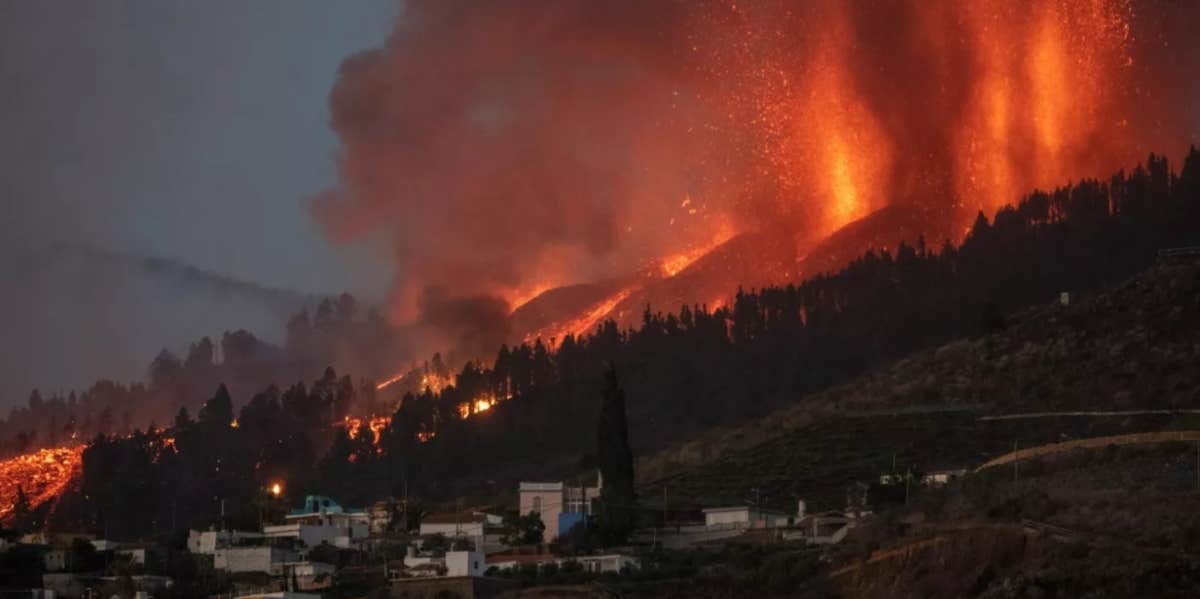Experts Address Fears That A Mega-Tsunami Will Hit The East Coast After Volcanic Eruption In The Canary Islands
Will there be a ripple effect?
 Desiree Martin / Getty
Desiree Martin / Getty A volcano on the Spanish Canary Island of La Palma erupted on September 19, 2021, initially forcing the evacuation of around 5,000 people from their homes in villages in the area.
It marked the volcano's first eruption since 1971, and sparked fear in the population on the east coast of North America over mega-tsunami fears.
On Oct 10, 2021, blocks of molten lava as large as 3-story buildings fell down the hills of the Spanish island.
Earthquake tremors are continuing to shake the island more than 6 weeks after the volcano's first eruption.
Is the La Palma volcano eruption going to cause a tsunami on the east coast of America?
A tsunami is unlikely to hit the east coast because of the volcanic eruption in Europe. Though that hasn't stop fear from spreading.
These fears and assumptions come from a 2001 scientific study published in the journal Geophysical Research Letters.
“Geological evidence suggests that during a future eruption, Cumbre Vieja Volcano on the Island of La Palma may experience a catastrophic failure of its west flank, dropping 150 to 500 km3 of rock into the sea,” according to authors Steven N. Ward and Simon Day.
This would cause tsunami-sized waves to “transit the entire Atlantic Basin” and hit the east coast of the United States with waves up to 100ft tall, or even more.
However, even if a large part of the mountain were to fall, the idea that the waves created from the impact could travel across the entire Atlantic basin is farfetched.
According to George Pararas-Carayannis, editor of the journal Science of Tsunami Hazards, “the threat of mega tsunami generation from massive flank failures of island stratovolcanoes has been greatly overstated.”
In 2002, Pararas-Carayannis released a study of his own, outlining the problems with the 2001 study and assuages everyone’s fears.
“Massive flank failures of island stratovolcanoes are extremely rare phenomena and none have occurred within recorded history,” says Pararas-Carayannis. “Recent numerical modeling studies . . . have been based on incorrect assumptions of volcanic island slope instability, source dimensions, speed of failure and tsunami coupling mechanisms.”
This all means that the numbers that Ward and Day used were incorrect inputs based on assumptions they made for an event that has never occurred before and “led to overestimates of tsunami far field effects.”
Janine Krippner, a volcanologist at the Global Volcanism Program, says that the public fear of a potential mega-tsunami points to a much larger problem.
"This scenario has been discredited by researchers but it is rampant right now. Why? Because we are drawn to what scares us even when it is not real," she told Newsweek. "Headlines take the smallest hint of truth and turn it into an irresistible boogeyman, causing real stress and harm around the world.”
Fortunately, the National Tsunami Warning Center has said that there is no tsunami danger for the East Coast based on all of the information they have, including water levels.
The most noteworthy tsunami that has hit the east coast in recent years happened in 1929 when a magnitude 7.2 earthquake made waves near Newfoundland, Canada.
Most, if not all, of the tsunami energy may have been triggered by a submarine landslide, causing 2-7 meter run ups concentrated on the coast of Newfoundland, though it was recorded as far south as South Carolina.
The 1755 Lisbon earthquake, which was measured at an 8.4 on the Moment Magnitude scale, created waves that reached across the Atlantic Ocean, but didn’t go higher than 1 meter in wave length.
Like the Gulf Coast, there are a couple of reports of small tsunamis hitting the east coast from Caribbean earthquakes, all less than 1 meter.
Needless to say, there’s not much to fear in terms of a mega-tsunami that could hit the east coast from this volcanic eruption, but it is possible.
On an odd note, in a 2003 episode of The Simpsons, a TV show some believe is known for "predicting" events like Donald Trump becoming president and even the Covid-19 lockdown, showed the Canary Islands missing the Western flank, presumably from a landslide. That is the exact area researchers are concerned would slide into the ocean and cause a mega tsunami. Surely it's just a strange coincidence, right?
RELATED: Did The Bible Predict Covid? The Scripture That Has People Convince We Are In The "End Of Days"
Isaac Serna-Diez is a writer who focuses on entertainment and news, social justice and politics.

